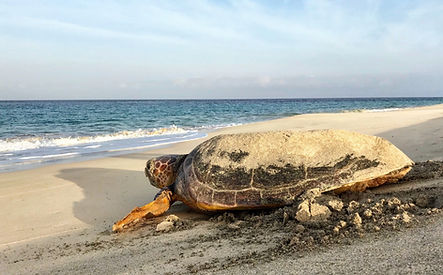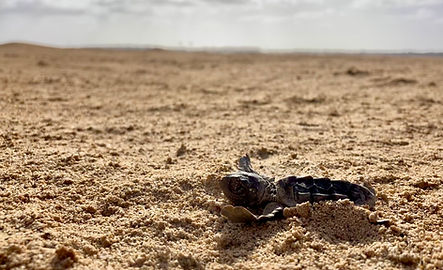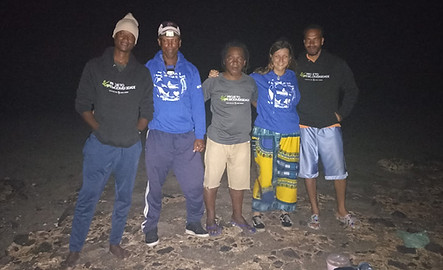
Witness a Natural Wonder
in Cabo Verde
Are you an eco-conscious traveller looking for your next great adventure? Just a six-hour flight from main cities in Europe lies an archipelago that hosts one of nature's most remarkable marine species. Each year, between June and December, Cabo Verde's pristine sandy beaches become vital nesting and hatching grounds for the world's largest population of loggerhead turtles (Caretta caretta).
_edited_edited_edited_edited_edited.jpg)
As night falls on these beautiful beaches during this period, hundreds of female sea turtles emerge from the sea to lay their eggs, and months later, thousands of baby turtles journey back toward it, continuing a ritual that has endured for millions of years.
But this intricate cycle now depends on a delicate balance between conservation, community, and responsible, eco-conscious tourism.
Important note: If you are considering touring in Cabo Verde, remember that opportunities to observe nesting sea turtles are only allowed from the 15th of July until the 30th of September. Dates for 2025: 1st of July until end of October, excluding specific nesting beaches.

An endangered species
Today, Cabo Verde’s loggerhead population is recognised as one of the 11th most threatened sea turtle population worldwide, with challenges that intensify during the nesting and hatching seasons. Cabo Verde diverse marine life includes 5 different sea turtle species. Their struggle for survival spans across centuries.
Historically, passing ships would capture these majestic creatures for their ability to survive prolonged periods without food—providing a reliable source of fresh meat during lengthy voyages. During World War II, communities also turned to turtles as a crucial food source during periods of extreme hardship.
Today, these highly endangered creatures face new threats and persistent old ones.
Nesting season threats
During the nesting season (June to October), female turtles face a variety of dangers. After surviving their journey to Cabo Verde, mothers attempting to nest on beaches often encounter stray dogs, brought over by humans initially, that attack them as they make their way up the beach. Stray dogs sometimes end up killing the adult turtles and feast on the freshly laid eggs and hatching babies. In addition, due to rapidly increasing coastal development, critical nesting beaches are increasingly threatened due to habitat loss.

Some of these threats include, but are not limited to:

Coastal construction: In Cabo Verde, constructions on beaches disrupt beaches where turtles nest, compromising reproductive habitats and threatening delicate ecosystems by replacing habitats with buildings.

Increased human activity driven by tourism: Touristic activities such as, illegal tours, beach parties, horse riding, and the use of quads and cars on the sand not only disturb the natural balance but also contribute to the destruction of vital habitats such as dunes.
The above, combined with the growing presence of artificial lighting along coastlines due to coastal activity, disrupts natural nesting behaviour, causing many sea turtles to abandon their nesting attempts. In addition, despite legal protections, nesting females still fall victim to poaching in Cabo Verde—a common threat during the nesting period. The consumption of sea turtle meat has a long history and tradition in Cabo Verde. Due to conservation efforts across the islands, there has been a reduction in poached nesting females; however, the practice persists, posing a significant threat to endangered species like the loggerhead turtle and other sea turtle species.

Hatching season threats
Threats continue and even intensify during hatching season (August to December) when the baby turtles hatch. Newly emerged hatchlings face predation from the moment they break through their shells. Those that survive must navigate beaches increasingly altered by coastal development, with artificial lighting disorienting them from the sea’s natural glimmer—a deviation that proves fatal. Over the last 50 years, the formerly simple trek to the sea has become a dangerous maze of obstacles, significantly reducing their already slim odds of survival.
The significance of sea turtle conservation in Cabo Verde
For these reasons, Project Biodiversity, a Cabo Verdean NGO based on Sal Island that focuses on ecosystem conservation, has implemented conservation programmes to reduce turtle mortality rates during both critical seasons. Their efforts, combined with the support of other local associations and the government, represent these sea turtles’ best hope for survival during their arrival and departure from Cabo Verde.

Global impact
The beaches of Cabo Verde, particularly those on Sal, Boavista, and Maio island, have earned their place in marine conservation history due to their significant nesting populations.
Here’s why:
-
Cabo Verde is one of the world’s most important sites for loggerhead turtle conservation. Current research indicates that its shores host approximately 15% of the global loggerhead turtle nesting population, securing its position as the world’s third-largest nesting site.
-
The numbers are striking: from just 10,000 nests recorded in 2015 to over 200,000 nests documented in recent nesting season periods, a testament to the success of ongoing turtle conservation efforts by Project Biodiversity and other local NGOs.
-
The regional population (or Regional Management Unit) of loggerhead turtles actively studied in Cabo Verde is considered endangered, whilst loggerheads globally are classified as vulnerable. This means the loggerhead population inhabiting Cabo Verde and West African waters faces a more significant threat to its survival. Additionally, research suggests the genetic differences that exist between loggerhead populations that inhabit these regions make them vital stabilisers for the global loggerhead population. This makes it more critical than ever to protect and preserve the loggerheads in and around West Africa. You can find more information on this here.
From nesting to hatching:
A season of discovery
A remarkable natural cycle begins as warm summer nights descend on Cabo Verde's shores. Female loggerheads, weighing up to 150 kg, migrate from feeding grounds along the West African coast — between Senegal and Sierra Leone — to reach these critical nesting sites. While nesting occurs across the archipelago, the island of Boavista hosts an extraordinary 60-70% of the country's nesting population, with Sal Island maintaining the second-largest rookery.

Modern research techniques have revolutionised our understanding of this ancient cycle. Thermal imaging drones patrol vast stretches of beach, detecting both nesting mothers and potential threats, while GPS and satellite tracking reveals the complex movement patterns of females during the nesting season. These innovations have uncovered previously unknown aspects of loggerhead behaviour, including males gathering in nearby waters during peak nesting periods.
The season has a fascinating overlap in turtle activity. By late August, while mothers continue arriving, the first hatchlings emerge from the early-season nests. This simultaneous nesting and hatching period creates a remarkable window in which researchers can study both life stages simultaneously, providing crucial insights into population dynamics and survival rates.

Conservation challenges
in a changing world
Despite encouraging growth in nesting numbers over the last few years, loggerhead turtles face persistent challenges. Historical threats have decreased significantly through community education and patrol programmes, but new challenges remain. Climate change affects sand temperatures — crucial for stable hatchling gender ratios — while coastal development and light pollution disturb both nesting mothers and hatchlings.
The rise of responsible ecotourism
The increasing presence of nesting turtles has sparked interest in turtle-watching experiences, presenting both opportunities and challenges for conservation. When properly managed, responsible ecotourism practices generate vital support for conservation efforts and the local community in Cabo Verde while raising awareness.
Visitors can now witness the nesting process through guided tours that prioritise the turtles' well-being and maintain strict protocols about lighting, distance, and group sizes. However, due to easy access to nesting beaches, tourists often wander along nesting beaches alone or with self-appointed, unqualified, and illegal guides, which disturbs and endangers the females, inadvertently destroying nests and increasing the risk of treading on freshly hatched baby turtles.
So, if you are planning on visiting Cabo Verde during the turtle season, you can help protect adult nesting areas by avoiding all beaches during nighttime from June until October. Additionally, we request that you book tours only with certified guides to observe the nesting process. This way, you can ensure observations do not cause harm and support Cabo Verde’s national protection efforts. Remember, it is a privilege to witness these beautiful creatures in their natural habitat, so ensure your activity does not lead to harm!
Guideline to nesting sea turtle observations
To ensure your nature excursions are not harming sea turtles, follow these guidelines:

Do not go to beach at night
All beaches on Sal island are nesting beaches, wether in front of 5 star resorts or apartments of Santa Maria. By strolling around at night on the beach alone, you will inadvertently disturb and harm not only sea turtles, but their nests. This is why it is illegal to go to the beach at night to observe nesting sea turtles without a guide during the nesting season, from June to October.

Take government certified tours
Regulating wildlife excursions supports the protection of the species from harmful human activities. The government has created strict rules to ensure that no sea turtles, nests or babies are harmed during touristic activities. By joining government licensed tour operators you support the well-being of sea turtles.

Prepare for your walk
-
only wear dark clothes
-
do not smoke or drink
-
do not wear perfume
-
turn all lights off and remove flash from your phones
-
you will walk in the dark without light

Getting to the beach
-
walk slow, stay quiet, do not step on tracks and nests
-
only approach the turtle once she has started laying her eggs
-
maximum 10 people are allowed behind a nesting sea turtle
-
do not walk on dunes or plants

Observe the turtle
-
never put light in her face
-
never touch the turtle
-
keep the way to the ocean clear
-
do not follow the turtle back to the water

Report Violations
To help improve wildlife tours, ensure the enforcement of rules and help protect sea turtles, report any misconduct or violations during your observation tours to the authorities by filling out this form. Regulations are newly enforced in Cabo Verde and the tourists' support is vital to ensure responsible and sustainable sea turtle observation tours.
Community and conservation:
a vital partnership
The success of turtle conservation in Cabo Verde stems mainly from its integration with local communities. Local fishermen have become the most passionate advocates for turtle conservation, adopting sustainable fishing practices that protect marine life and their livelihoods.
This transformation demonstrates how sustainable practices can benefit wildlife and local economies during the sea turtle seasons.

The role of international support
In conjunction with local community mobilisation, the preservation of Cabo Verde's loggerhead population relies heavily on international collaboration, which includes, but is not limited to:
-
Collaboration with leading universities, such as the Queen Mary University of London
-
Organisations working to increase awareness of sea turtle conservation, such as the International Sea Turtle Society and the regional initiative led by PRCM.
-
Organisations actively working alongside communities and NGOs to enhance sea turtle conservation and protection efforts, such as the TUI Care Foundation.
-
International volunteers who partner with conservation NGOs, such as Project Biodiversity, to assist in the conservation effort


These are just some of the dedicated individuals and groups who actively contribute to vital research, monitoring, and protection efforts during nesting and hatching seasons. These programmes support a greater scientific understanding of the sea turtle, their hatching and nesting season, and the threats they face whilst strengthening the bonds between international conservation communities.

The Future of Turtle Conservation
in Cabo Verde
Whilst the increasing nesting numbers offer hope, sustained effort is crucial for the long-term survival of Cabo Verde's loggerhead turtles. The archipelago's waters have an abundant marine life, creating a rich ecosystem that depends on continued protection. As climate change poses new challenges, conservation work becomes even more critical.
A call to action
As the nesting season begins for incoming sea turtles, the Project Biodiversity team, also gears up to welcome thousands of turtles and many international volunteers who work alongside the local community in Cabo Verde to enhance and support turtle conservation efforts on Sal Island.
The story of Cabo Verde's loggerhead turtles demonstrates the profound impact of dedicated conservation efforts. For those passionate about marine conservation, few experiences rival the opportunity to witness and support this crucial work firsthand. Whether through responsible tourism or more involved participation, every contribution helps ensure these magnificent creatures continue to find sanctuary on Cabo Verde's shores.
Are you thinking
of visiting Cabo Verde?
Project Biodiversity offers two distinct volunteer experiences aligned with the natural rhythm of turtle seasons. During nesting season (June to October), volunteers join night patrols to protect nesting mothers, assist with essential fieldwork, and help relocate vulnerable nests. The hatchling season (September to December) focuses on monitoring conservation hatcheries and ensuring that baby turtles make their first journey to the sea safely—a truly magical experience that stays with volunteers long after they leave Sal's shores.

Both programmes offer hands-on conservation experience, with options from one to several weeks. Whether camping near nesting beaches or in shared accommodation in Santa Maria, you'll work alongside passionate conservationists while experiencing Sal Island's unique culture and biodiversity.
For detailed programme requirements, costs, and accommodation information, visit Project Biodiversity's Sea Turtle Volunteering Programme.
Tourist information:
Observing Adult sea turtles
-
The nesting season runs from June until October in Cabo Verde
-
Turtle-watching must only be done through guided tours with certified guides from the 1st of July until October (end date depending on the season).
-
Tours must follow strict protocols regarding lighting, distance from turtles, and group sizes
-
Tourists should avoid all beaches during night-time throughout the nesting season to protect sensitive nesting females
Observing baby sea turtles
-
Observations for the hatching season typically begin from the end of August until the beginning of December in Project Biodiversity’s sea turtle conservation hatchery.
-
Once the hatching season begins, Project Biodiversity holds daily public talks starting at 16h30 on the sea turtle conservation hatchery next to Hotel RIU Funana.
-
Usually, these talks precede nest excavations for turtles that have hatched the previous night; this gives tourists a great opportunity to witness the hatching process.
-
Please note: Project Biodiversity does not provide public sea turtle releases; tourists can only observe the excavations of the nests. There is no payment for the activity, they are free and open to the public, while donations to support the work are welcome.
.png)

